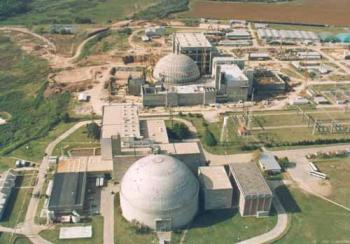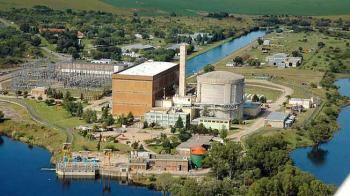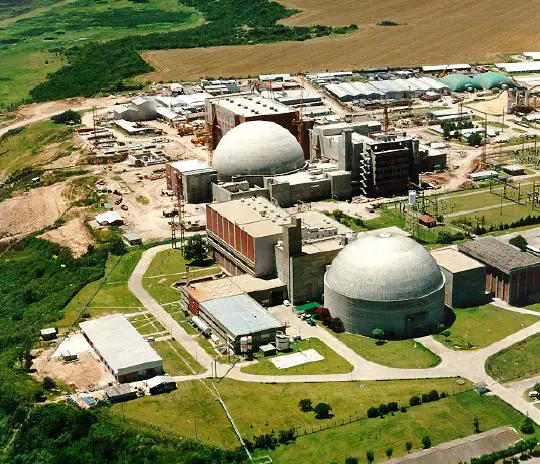
In Argentina, electric power production is largely privatized, and is regulated by the ENRE (National Electricity Regulatory Entity). The installed capacity of the entire energy matrix is about 35 GW, around 11% of which is from autoproducers and private generators.
Argentina was the first country in Latin America to use nuclear energy. About 10% of the electricity comes from three nuclear reactors:
| Nuclear Power Plants | Reactors | |
|---|---|---|

|
Atucha. Lima | 2 |

|
Embalse. Cordoba | 1 |
In addition to the Atucha and Embalse nuclear power plants, there are also other research reactors in the country. In addition, Argentina exports nuclear technology.
Argentina has been a party to the Nuclear Non-Proliferation Treaty (NPT) since 1995 as a state without nuclear weapons.
The Nuclear Non-Proliferation Treaty is a treaty that restricts the possession of nuclear weapons and is therefore part of the international community's efforts to prevent the proliferation of weapons of mass destruction. According to the treaty, this energy source should only be used for civil purposes.
History of nuclear energy in Argentina
In 1950 the National Atomic Energy Commission (CNEA) was created. This commission led to a series of activities focused on nuclear energy research and development, including the construction of several nuclear research reactors.
They are currently operating five nuclear research reactors with the anticipation of building a sixth nuclear power reactor.
Atucha I nuclear power plant
Interest in this type of energy began in 1964. Then, the country carried out a feasibility study to build a plant in the province of Buenos Aires of 300 to 500 MW.
 The country's policy was firmly based on the use of heavy-water nuclear reactors using natural uranium as a nuclear fuel. The most attractive offers that were finally accepted were those from Canada and Germany.
The country's policy was firmly based on the use of heavy-water nuclear reactors using natural uranium as a nuclear fuel. The most attractive offers that were finally accepted were those from Canada and Germany.
The nuclear fuel used in Atucha I is a mixture of natural uranium and slightly enriched uranium.
The Atucha 1 nuclear power plant came into operation in 1974, becoming the first Argentine nuclear power plant.
Embalse nuclear plant
In 1967, a second feasibility study was conducted for the construction of a larger nuclear power plant at the Reservoir in the Córdoba region, 500 km inland.
In this case, a CANDU-6 reactor from Atomic Energy of Canada Ltd. (AECL) was selected, in part because of the accompanying technology transfer agreement, and was built with the Italian company Italimpianti. The Embalse nuclear power plant came into operation in 1984.
The plant has recently undergone a life extension plan and is ready to operate for another 30 years.
Atucha II nuclear power plant
In 1979, a third nuclear power plant was planned in Argentina - Atucha 2 - as a result of a decision by the Argentine government to have four more units that would come into operation between 1987 and 1997.
Construction of the Siemens-designed plant began in 1981. However, work was suspended in 1994 due to lack of funds with 81% of the plant built.
In 1994, Nucleoeléctrica Argentina SA (NASA) was created to take over the CNEA nuclear power plants and supervise the construction of Atucha 2.
In 2003, plans were presented to complete Atucha 2's 692 MW. In August 2006, the government announced a US $ 3.5 billion plan to develop nuclear power in Argentina. The aim was to complete Atucha 2 and extend the operational life of Atucha 1 and Embalse.
Enrichment plant
In December 2015, a new uranium enrichment plant was inaugurated to make fuel for Argentina's nuclear plants, located in Pilcaniyeu. The plant will use more modern laser and gaseous diffusion techniques.
CAREM research reactor
The CAREM reactor is a nuclear reactor designed to be used for the generation of electricity (100 MW thermal and 27 MWe net) or as a research reactor or for the desalination of water. It is a simplified pressure water nuclear reactor with integral steam generators.
The CAREM nuclear reactor - developed by CNEA and INVAP - is currently in the construction stage in the northwestern province of Formosa.
What are the uranium resources in Argentina?
Argentina's uranium resources are only about 15,000 tU, despite the CNEA estimating that there are about 55,000 tU as "exploration targets." Starting in the mid-1950s, uranium exploration and some mining were carried out, but the last mine closed in 1997 for economic reasons.
However, in Argentina there are plans to reopen the Sierra Pintada CNEA mine in Mendoza, in the center-west, closed since 1997. It is also known as the San Rafael mine and the Mill. The resumption of uranium mining is part of the 2006 plan.
In 2007, the CNEA reached an agreement with the Provincial Government of Salta, in the north of the country, to reopen the Don Otto uranium mine, which operated intermittently from 1963 to 1981.